|
|
 |
|
June 29, 2011
For American wine-lovers visiting French grape growing regions, no matter whether Bordeaux or Burgundy, Champagne or Alsace, the last night abroad can prove bittersweet. That’s not only because their wonderful vacation is about to end, but also because they’ll probably need to be at the airport--usually Charles de Gaulle outside of Paris--fairly early the next day. Unless they’re willing to get up before dawn and drive like a bat out of you-know-where, they need to find a hotel, and a restaurant, nearby.
I can’t help with the hotel, but I do have a restaurant recommendation. Two weeks ago, when returning from just such a trip, my wife Marguerite Thomas and I ate at L’Auberge de la Brie in the small town of Couilly-Pont-aux-Dames, about a thirty minute drive from the airport. It was the best meal I’ve had anywhere this year. of Couilly-Pont-aux-Dames, about a thirty minute drive from the airport. It was the best meal I’ve had anywhere this year.
Carrying one Michelin star, this is a fairly unpretentious restaurant serving quite sophisticated fare. Its small dining room, painted in warm pastels, looks out over a small garden and feels very inviting. As at most good French restaurants, a dinner reservation gets you a table for the whole evening. We arrived around eight, and didn’t leave until after eleven. On a June evening in northern France, dusk lingers long, and the light faded ever so slowly during our time there.
The highlights of our meal included a very imaginative cold fois gras dish served in a small bowl made out of brioche, with Spanish Ibérico ham and diced, marinated artichokes lurking underneath; a rich, satisfying sweetbread entrée; and a deep, earthy dish of squab, spinach, and shallots, with more (this time warm) fois gras beneath the bird for good measure. While the desserts were fine, they didn’t match the quality of these savory dishes, the memory of which makes my mouth water as I write. The cheese cart, though, was well worth ordering. As the restaurant’s name suggests, this is Brie country, and we sampled a variety of different ones.
The wine list at L’Auberge de la Brie, though not especially big, offers many reasonably priced choices, including a small but well-chosen set of wines by the glass. Drinking well there won’t break the bank. We enjoyed a glass of sumptuous off-dry Jurancon with the fois gras, and bottle of deep, rich St.-Joseph with the rest of the meal.
As at most French restaurants, you’ll do best ordering a set menu rather than a la carte. There are a number of options, starting at forty-six Euros and going up to sixty-nine--not cheap certainly, but more than fair given the high quality of chef Alain Pavard’s cooking.
On the Saturday evening when we were there, the restaurant was filled with happy couples and families, talking softly but amiably, the sound of laughter joining with the clink of glassware to set a festive mood. L’Auberge de la Brie appears to be more of a special occasion restaurant for locals than a destination spot for jet-setters. It’s very comfortable and relaxing, a perfect place to spend a final evening in France. I can’t recommend it more highly.
Auberge de la Brie
14, avenue Alphonse Boulingre
77860 Couilly-Pont-aux-Dames
tel : 33 (0)1-64-63-51-80
Posted by Paul Lukacs at 8:55 AM
|
|
June 28, 2011
The Wine Media Guild has voted Gerald Boyd into its Wine Writers’ Hall of Fame. Only 23 wine writers have been received this honor, which we believe is richly deserved by Gerald on grounds of his longstanding contributions to wine criticism and appreciation. Distinguished by broad knowledge, a discerning palate, and unimpeachable integrity, I’ve admired Gerald since first meeting him in the mid-1990s, and am delighted to offer congratulations on behalf of all of us at Wine Review Online. appreciation. Distinguished by broad knowledge, a discerning palate, and unimpeachable integrity, I’ve admired Gerald since first meeting him in the mid-1990s, and am delighted to offer congratulations on behalf of all of us at Wine Review Online.
(As long as I’m waxing prideful, I might also note that Gerald will be joining two other WRO contributors in the select ranks of the Hall of Fame, namely, Mary Ewing-Mulligan and Ed McCarthy.)
Gerald could not be present in New York for his induction, but I’ve come into possession of the acceptance speech he sent to the event, which I’ll reprint here in its entirety. Once again, Gerald, congratulations!
* * *
"I’ve asked my old friend, Kevin Zraly, to read these few words tonight for two reasons: the first and most obvious is I am not here to do it myself. The second reason is Kevin and I share some history in the development of wine appreciation in the United States.
In the late 1960s, while living in Colorado, I decided to try my hand at wine writing. Only a handful of wine writers were active then, concentrated on both coasts, with the exception of America’s first woman wine writer, Ruth Ellen Church, in Chicago. Today, there’s no telling how many people are writing about the pleasures of wine; a positive sign that consumers are still thirsting for more knowledge and tasting experiences.
Eventually, with all that writing and exposure, the floodgate opened with wine flowing everywhere in America’s major cities. One person who knew a trend when he saw one is Kevin Zraly, founder of the Windows on the World wine course. In the late 1970s, Marvin Shanken, owner of The Wine Spectator and Kevin put their heads together and came up with the first major wine summit in the United States. I was the editor of The Wine Spectator then and I can tell you that I was impressed at how fast things were moving and how many people wanted to get on board the wine juggernaut.
It was the dawning of a new wine age and I was smack in the middle of it. In those days, The Wine Spectator was at the vanguard of wine publications, but it wasn’t the only journal striving to inform American wine consumers about the proliferation of wines that seemed to be emerging from every corner of the world. And I wanted to be part of that surge, so I returned to free-lance writing where I’ve been to this day.
There is one more chapter to my journey as a wine writer -- electronic media. Among the members of my family and friends, I am known as a Luddite when it comes to embracing the digital world. But embrace I did by writing a column for the Internet site Wine Review Online. It was an easier transition than I had ever imagined, from the printed word to the electronic word, but for me it is almost a career come full circle.
So, it is with humility and pride that I accept this honor tonight, knowing that in some small way, I helped to teach Americans about wine and encouraged other writers to try their hand at wine writing. My thanks to the Wine Media Guild for recognizing my contributions and to Kevin Zraly for helping me to open one small window into wine’s past history. Thank you!"
Posted by Michael Franz at 7:58 AM
|
|
June 27, 2011
With the 4th of July soon upon us it seems fitting to pay homage to the first president of our new nation, who deserves our gratitude not just for his military and political acumen, but also for his contribution to American spirits. What many people don’t know about George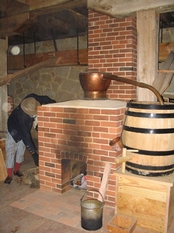 Washington is that he was both the father of our country and the father of American whiskey. Washington is that he was both the father of our country and the father of American whiskey.
Like most early European settlers in America, Washington was not a stranger to hard liquor. Because wells, cisterns and even rivers had already been contaminated by runoff from privies or the waste from un-penned animals, clean drinking water was hard to come by. And because refrigeration and pasteurization hadn’t yet been invented, there really was no such thing yet as fresh fruit juice. Coffee and tea were occasional options for wealthier citizens, but these heavily taxed luxuries were too expensive and rare for most people. All of this left alcohol, with its purifying properties, as just about the only safe thing to drink.
Not surprising, then, that one of the principal goals of 17th century colonists was to establish a reliable supply of alcoholic beverages.
Beer had slaked the thirst of most of the world for eons, but early attempts to raise barley and hops in the new land were disappointing. Growing grapes for winemaking proved an even more unsatisfactory enterprise since native American grapes produced wines that did not appeal to most palates, while European vinifera species inevitably succumbed to American vine diseases. America’s earliest emigrants managed to produce reasonably palatable fermented brews from the native cornucopia of pumpkins, persimmons, maple syrup and even corn husks. The most successful beverages were made from apples, and fermented apple cider and brandy became household staples.
During the Revolutionary War General Washington supplied his troops with applejack, for like most people he was convinced that booze kept soldiers’ bodies warm, their digestions healthy and their spirits upbeat. In a letter to John Hancock he wrote that “benefits arising from moderate use of liquor have been experienced in all armies and not to be disputed.”
Mount Vernon’s farm manager, John Anderson, who had learned the art of distillation back home in Scotland, had long urged his boss to create a distillery at Mount Vernon. When he retired from politics, Washington decided to pursue the idea.
Washington established the distillery on one of his properties about three miles south of Mount Vernon. The building, completed in March 1798, was a 75 by 30 foot structure that housed five copper stills, a boiler, and fifty mash tubs. In the beginning, only corn and other grains from Mount Vernon’s own fields were used for the mash, but as demand grew, neighboring farmers provided him with additional grain in return for whiskey. By 1799, only two years after production had begun, Washington was probably the nation’s largest whiskey distiller, turning out 11,000 gallons of whiskey valued at $7,500.
Washington’s whiskey business was definitely a commercial venture: The entire production was purchased by twelve merchants in Alexandria, Virginia, who sold it in their retail establishments. The successful enterprise was short-lived, however, for Washington died two years after the stills were first fired up. A nephew inherited the distillery, but under his hand the business faltered and soon vanished altogether. The distillery fell into complete disrepair, and in 1814 burned to the ground.
In 1997, workers at Mount Vernon uncovered five copper stills and a few other artifacts that provided precise clues to Washington’s distillery 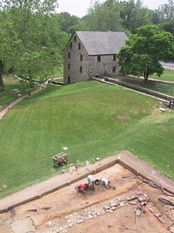 operations. In 2005, a team of archaeologists and other experts, funded by grants from the Distilled Spirits Council and the Wine and Spirits Council of America, began rebuilding a replica of George Washington’s distillery on top of its original foundation. The new distillery closely mimics the original operation, with a few concessions to 21st century building codes. At the new facility distillers demonstrate the methods Washington used to make whiskey. According to Mount Vernon officials Washington’s restored distillery is the only one in the United States that demonstrates authentic 18th century distillation techniques. operations. In 2005, a team of archaeologists and other experts, funded by grants from the Distilled Spirits Council and the Wine and Spirits Council of America, began rebuilding a replica of George Washington’s distillery on top of its original foundation. The new distillery closely mimics the original operation, with a few concessions to 21st century building codes. At the new facility distillers demonstrate the methods Washington used to make whiskey. According to Mount Vernon officials Washington’s restored distillery is the only one in the United States that demonstrates authentic 18th century distillation techniques.
Most consumers who taste the whiskey find its appearance and flavors unfamiliar. While it’s impossible to know exactly what Washington’s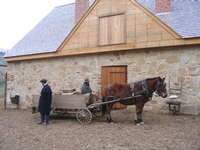 whiskey tasted like, we can assume that his was a clear liquid since 18th century whiskey wasn’t aged in barrels (wood gives whiskey its color and certain flavor components). For a description of what the whiskey tastes like one might turn to David Pickerell, who led the team that made the first whiskey at Mount Vernon’s restored distillery. Pickerell, who was at that time the Master Distiller for Maker’s Mark Bourbon, published these tasting notes on the Internet: whiskey tasted like, we can assume that his was a clear liquid since 18th century whiskey wasn’t aged in barrels (wood gives whiskey its color and certain flavor components). For a description of what the whiskey tastes like one might turn to David Pickerell, who led the team that made the first whiskey at Mount Vernon’s restored distillery. Pickerell, who was at that time the Master Distiller for Maker’s Mark Bourbon, published these tasting notes on the Internet:
Nose: Slightly floral, earthy, and grainy--reminiscent of freshly distilled Tequila.
Taste: Surprisingly sweet, but not overly so. Initial taste is primarily front palate. As the taste develops, it moves to the sides of tongue, revealing the un-aged grainy sourness. But again, not too sour. Finally the corn and rye grain tastes develop.
Finish: Fairly long and dry with the grain being most evident.
Overall: The taste is not nearly as aggressive as expected, surprisingly mellow and sweet.
Posted by Marguerite Thomas at 8:58 AM
|
|
June 22, 2011
The most interesting wine I drank during a family vacation in France last week was not the riveting grand cru Chablis I tasted while visiting a producer’s cellar, or the invigorating Sancerre I enjoyed in a restaurant, or even the sumptuous grower’s Champagne we lifted in toast on our last evening there. Instead, it was an inexpensive (seven and-a-half euros, so about eleven dollars) St.-Joseph that I bought at the local Intermarché supermarket.
Though not as illustrious as some of its neighbors, St.-Joseph is a fairly well-regarded appellation in the northern Rhône Valley. It lies south of Côte-Rôtie, east from both Crozes-Hermitage and Hermitage, and north of Cornas. Like the wines from those other appellations, its reds all are made with Syrah grapes. And while often lighter in body and somewhat riper-tasting than wines from those others, St.-Josephs nonetheless can display the tangy, pepper-filled, smoky, even meaty quality that distinguishes the finest northern Rhône reds.
This distinctive character, which is evident in both the wines’ aromas and their flavors, renders these French reds different from wines made with Syrah (or Shiraz) most anywhere else in the world. In turn, the wines are quite exceptional. The vast majority of red wines made in the world today taste primarily of fruit, with other notes playing a supporting part. In the northern Rhône, those roles often are reversed. With these wines, fresh fruit scents and flavors frequently play second fiddle to more notably earthy ones.
So it was with this St.-Joseph. It came from a cooperative, the name of which I didn’t think to write down, and it tasted unmistakably of its region. I can’t say that it was undoubtedly St.-Joseph (as opposed to, say, Crozes-Hermitage), but it could not have come from anyplace other than the northern Rhône. In short, it tasted nothing if not authentic.
This sort of stylistic authenticity is not the same as “terroir,” a term often misused these days. “Terroir” denotes specificity, a specificity literally rooted in a particular place. To be meaningful, it cannot apply to an entire region, or at least to one with nearly 950 hectares under vines (as in St.-Jospeph). By contrast, the sort of authenticity so evident in this particular wine comes in part from place, but also in part from winemaking vision. It’s a matter of style, and style results from human choice as much as from nature.
Now, in every other respect, this St.-Joseph was unremarkable. Fairly thin in body, with only adequate length on the palate, and not much overt fruit flavor, it was a fine eleven dollar wine, but not more. Were I to rate it for Wine Review Online, I would give it something between 85 and 88 points--a good score, surely, but not an exceptional one.
What I found so interesting about this wine, though, was that its strengths and weaknesses were almost exactly the reverse of virtually all of the many wines that I have given comparable scores to on this website over the years. Almost all of these have been filled with sometimes vivacious fruit flavors, but have lacked subtlety or nuance. Many of them have hailed from South Australia, California, and other New World grape-growing regions, but a fair amount also have come from Europe.
Regardless of geographical origin or of the grape(s) used to make them, these fruit-forward red wines define what has come to called wine’s “international style.” And at least in my experience living in the United States, they dominate today’s wine market. My supermarket St-Joseph was anything but international. I’ve tasted many better wines, meaning more complete so compelling ones, but few that manage to display the sort of stylistic authenticity that this fairly humble red did. That’s why, while not the inherently best wine I drank last week, it was definitely the most interesting.
Posted by Paul Lukacs at 9:57 AM
|
|
June 21, 2011
I was in charge of planning a week-long, adults-only family vacation. Where to go with relatives who have a passing interest in wine but don’t want to spend too much time traipsing through cellars and tasting rooms? California was out since most of us have lived in wine country there at one time or another, and besides we wanted to be in a place that was a bit more, well, foreign. Since most of us are Francophiles, France seemed the obvious choice. I first contemplated heading for Provence or Languedoc in the hopes of finding warm weather in early June, but in the end I decided against devoting so many hours of our precious seven days to the time it would take to travel to those admittedly seductive southern lands. I finally settled on Chablis, which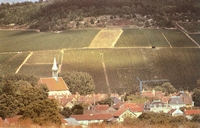 offers not only fine wines, but has the added advantage of being only a couple of hours’ drive from Paris airports. Another benefit of being based in Chablis is that it is within reasonable reach of a wealth of non-wine points of interest: Gorgeous cathedrals, fascinating towns, beautiful chateaux. offers not only fine wines, but has the added advantage of being only a couple of hours’ drive from Paris airports. Another benefit of being based in Chablis is that it is within reasonable reach of a wealth of non-wine points of interest: Gorgeous cathedrals, fascinating towns, beautiful chateaux.
I discovered La Maison de la Reine through an Internet search. A recently restored ancient beauty, the house sits on the banks of a small, scenic canal. It is endowed with six bedrooms (each with its own bathroom), comfortable living spaces, and a well-equipped kitchen. Originally the property of Marguerite of Burgundy, a regal heroine of the Middle Ages, the Maison de la Reine is the architectural and historic crown jewel of Ligny-leChatel. One of Chablis’ 20 wine villages, Ligny lies at the extreme northern perimeter of the region. For the wine lover, being in Ligny is a bit like standing at the edge of a leafy, green sea, with an ocean of vines stretching out before you, cresting and rolling to the distant horizon.
The region’s wine production is centered in and around the eponymous town of Chablis. There is no lack of wineries and tasting rooms here. We made an appointment for a tasting one morning at Louis Michel, located in downtown Chablis between the Hotel de Ville (town hall) and the Serein River, the wine region’s main waterway. Six generations of the same family have been making Louis Michel wines. From the charming, fruity and lightly minerally Petit Chablis to the stunningly complex top-of-the-range wines, including Grenouille, Les Clos, and Mondesir, this tasting put us all in a vinous state of grace.
Since we also wanted some insight into the wines of our own village, we made arrangements to visit Ligny-le-Chatel’s own Garnier & Fils. 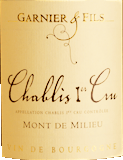 The winery is an easy stroll up the hill from the Maison de la Reine. Compared to Louis Michel, this is a very young family-run estate, founded in 1985 by the two Garnier brothers. Xavier takes care of the vines, Jerome is the winemaker, and their father, Joseph, a retired farmer, seems to do everything else (he was pasting labels on bottles the day we visited). Garnier’s vineyards extend over five districts, from Ligny-le-Chatel to Chablis, and cover two appellations: Chablis and Petit Chablis. The elegant Garnier Petit Chablis is soft and citrusy, the Chablis Premier Cru is rich and elegant, and the Mont de Milieu is sublimely silky, with a bite of salinity on the finish. We bought a few bottles of each of these--with prices at the winery ranging from about $10 for the Petit Chablis to roughly $14 for Mont de Milieu, who could resist? The wines were a wonderful addition to the dinners we cooked and savored at the Maison de la Reine, perched on the rim of Chablis. The winery is an easy stroll up the hill from the Maison de la Reine. Compared to Louis Michel, this is a very young family-run estate, founded in 1985 by the two Garnier brothers. Xavier takes care of the vines, Jerome is the winemaker, and their father, Joseph, a retired farmer, seems to do everything else (he was pasting labels on bottles the day we visited). Garnier’s vineyards extend over five districts, from Ligny-le-Chatel to Chablis, and cover two appellations: Chablis and Petit Chablis. The elegant Garnier Petit Chablis is soft and citrusy, the Chablis Premier Cru is rich and elegant, and the Mont de Milieu is sublimely silky, with a bite of salinity on the finish. We bought a few bottles of each of these--with prices at the winery ranging from about $10 for the Petit Chablis to roughly $14 for Mont de Milieu, who could resist? The wines were a wonderful addition to the dinners we cooked and savored at the Maison de la Reine, perched on the rim of Chablis.
Posted by Marguerite Thomas at 8:23 AM
|
|
June 19, 2011
If you attend enough wine tastings and seminars, it becomes pretty clear that all winemakers everywhere think that their wines are truly fabulous--or that they are commercially obliged to say so even if they know better. So, whenever I’m at a panel presentation and some winemaker issues a proclamation that he grows the “World’s Greatest Grape,” and that he grows it in the variety’s “Optimal Terroir,” I confess that my natural tendency is to roll my eyes and reach for my BlackBerry…or to roll up my sleeves and prepare for argument if the claim seems particularly egregious.
However, I attended a workshop last week where a winemaker made a claim roughly equivalent to the one I’ve parodied above--but was then backed up impressively by the wines being presented.
The event was one of a series of “WOSA Wine Workshops” being presented around the world by Wines of South Africa, and this panel in Washington, DC included four winemakers showing a dozen renditions of Chenin Blanc. The panel was led off by Ken Forrester, who is known for excellent wines but not for an overly reserved personality. The upshot of his introductory remarks was that Chenin Blanc is the world’s greatest white wine variety, and that the grape, which thrives in a cool sunshine, is at its very best in South Africa. for excellent wines but not for an overly reserved personality. The upshot of his introductory remarks was that Chenin Blanc is the world’s greatest white wine variety, and that the grape, which thrives in a cool sunshine, is at its very best in South Africa.
That is a severely concise paraphrasing of his remarks, but not an unfair one. Forrester was a bit more diplomatic than I’ve suggested here, noting in response to a question that Loire Valley Chenins can be fabulous when France’s capricious weather chooses to cooperate. Still, the clear subtext of the remark was that South African Chenins are the qualitative equals of their French cousins from appellations like Vouvray, Savennieres and Quarts de Chaume, but more consistent thanks to a more hospitable climate in South Africa.
This is just the sort of Big Claim that stirs up my biological fight-or-flight response, but the wines following it were so bloody good that nobody in the audience (including me) was inclined to argue the point or check out of the tasting.
The session was entitled “Chenin Blanc’s Diversity,” and diversity was indeed on display. The younger, leaner, simpler renditions of the grape showed great freshness and vivacity but also impressive breadth and depth on the palate. Ken Forrester’s own “Petit Chenin” bottling from 2010 was a delicious case in point, as were the wines from the same vintage by Bellingham and Mulderbosch.
At the opposite end of the spectrum, rich dessert-style renditions also showed beautifully, with Kanu Kia-Ora Noble Late Harvest 2006 and De Trafford “Straw Wine” 2007 both exhibiting an impressive intricacy of flavor and structure.
However, by my lights the best backers for the Big Claim were the essentially dry wines made from old vines with a little influence from oak and yeast lees. Three eye-popping cases in point were The Bernard Series Old Vine 2010; De Morgenzon 2007, and Ken Forrester “FMC” 2009. All three were generously fruited with layered flavors but still fresh and focused by lacy, mouth-watering acidity that energized the amazingly long finishes of the wines. I scored all three wines in a range between 92 and 95 points, and though they didn’t quite show the minerality of a great Chenin from Savennieres, they were richer and deeper and equally nuanced.
I’ve been fortunate to taste many Chenins from South Africa during three trips to the Cape region, but always in a sporadic manner rather than in a seated, focused tasting such as this recent one in Washington--which left me as impressed at the end as I was skeptical at the outset. I’m not quite ready to sign on to the Big Claim just yet, but I’m certainly resolved to continue testing it at every available opportunity.
Posted by Michael Franz at 12:40 PM
|
|
June 17, 2011
I've never understood the "cult" wine phenomenon, which is an affliction that seems to be contained largely to the Napa Valley.
It goes something like this: Rich guy (or gal, in the case of Ann Colgin) takes a choice plot of vineyard land in the Napa Valley. Then he or she plants Cabernet Sauvignon (the money grape, of course), hires an expensive consultant, and makes small amounts of very expensive Cabernet that is sold to other rich folk who line up to overpay for a so-called cult Cab.
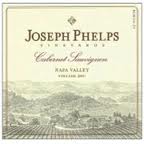 These wines take on a life of their own once they escape the winery, fetching small fortunes at auction and when they occasionally turn up in a retail wine shop. It's common, for example, to see a bottle of Screaming Eagle for more than $1,000 per bottle. These wines take on a life of their own once they escape the winery, fetching small fortunes at auction and when they occasionally turn up in a retail wine shop. It's common, for example, to see a bottle of Screaming Eagle for more than $1,000 per bottle.
I would be the first to tell you that the Napa Valley produces incredible Cabernet. So, the cults Cabs are no doubt very good. But the dirty little secret is that you don't have to own a hedge fund and pay outrageous sums to get your hands on an incredible Napa Valley Cabernet. You merely have to know where to look.
I was reminded of that fact recently when I tasted Cabernet Sauvignons from two venerable Napa Valley producers, Grgich Hills Cellars and Joseph Phelps Vineyards. Over the past 25 years, they have been among the best in the valley at the money grape, Cabernet Sauvignon. My cellar was once stocked with Grgich and Phelps Cabs from the 1980s and 1990s. Sadly, those stocks have dwindled over the years, but I still have bottles of Cabernet from the early 1990s from each winery.
I am happy to report that these wines are in impeccable condition and have been magnificent each time that I've opened one in recent years. It is hard to imagine how any "cult" Cab made today could be any better 10, 15 or 20 years from now.
So I present to you the 2007 Grgich and the 2008 Phelps Cabernets, $60 and $56, respectively. You will see that I found both wines to be quite profound. Neither wine is inexpensive in the literal sense, but both wines are amazing bargains when compared to the cost of a cult Cab.
If you have a wine cellar, or you're even thinking about having a wine cellar, these wines should be high on your shopping list. Or if you simply want a dazzling Napa Valley Cabernet for a special occasion or a gift, but don't want to take out a second mortgage, either of the two would serve you well.
On the other hand, if you absolutely must make a statement to impress someone, go ahead, be my guest and purchase a cult Cab. But don't expect me to understand.
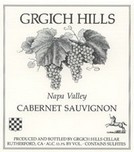 Grgich Hills Cellars 2007 Cabernet Sauvignon Estate ($60) — Given the inflated cost of Napa Valley Cabernet Sauvignon, the marvel of Grgich's '07 vintage is that it only costs $60. That's chump change in a region where Bryant, Scarecrow, Grace Family, Screaming Eagle and the like go for hundreds, even thousands, of dollars. But no Napa Cab over the past two decades has been more reliable than Grgich Hills, whose Cabs from the late 1980s and early 1990s continue to hold up very well. The '07 is beautifully structured with dense layers of dark fruit and spice, firm tannins and a hint of cedar and vanilla on the finish. It is truly an astonishing Napa Cab for the price. 96. Grgich Hills Cellars 2007 Cabernet Sauvignon Estate ($60) — Given the inflated cost of Napa Valley Cabernet Sauvignon, the marvel of Grgich's '07 vintage is that it only costs $60. That's chump change in a region where Bryant, Scarecrow, Grace Family, Screaming Eagle and the like go for hundreds, even thousands, of dollars. But no Napa Cab over the past two decades has been more reliable than Grgich Hills, whose Cabs from the late 1980s and early 1990s continue to hold up very well. The '07 is beautifully structured with dense layers of dark fruit and spice, firm tannins and a hint of cedar and vanilla on the finish. It is truly an astonishing Napa Cab for the price. 96.
Joseph Phelps Vineyards 2008 Cabernet Sauvignon, Napa Valley ($56) — Once upon a time, it wasn't unheard of for Phelps to produce a Cabernet that could compete alongside its iconic red meritage, Insignia, despite the enormous difference in price. Improvements in the Insignia vineyard sources over the years have created a bit of space between the two wines, but that gap may once again be narrowing. The '08 Phelps Cab is one of the finest Phelps Cabs in years. It is a well-proportioned stunner that exhibits density on the palate with layered black fruit flavors, an underpinning of supple tannin and firm acidity, and hints of cedar, forest floor and spice. Drink this impressive Napa Cab now, or cellar it for up to 15 years. 95.
Posted by Robert Whitley at 7:08 AM
|
|
June 14, 2011
This is a tale of two--no, three--wines. The first is a bottle that had gotten lost in my cellar, a 2005 Condrieu from Guigal. This wine had been delicious four years ago, when I last tried it. Made with Viognier grapes, it offered enticing honeysuckle and jasmine aromas, fresh stone fruit flavors, and a creamy texture, offering the beguiling combination of finesse married with weight that distinguishes this grape variety at its best.
The second wine is also a Viognier. This one was made by Barboursville Vineyards in Virginia, and hailed from the 2002 vintage. I had the opportunity to try it a couple of weeks ago, at a dinner in Washington, D.C., hosted by Barboursville’s winemaker, Luca Paschina. While I had tried other vintages of this wine before, I had not 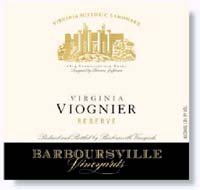 tasted this one, and certainly not at nearly nine years of age. tasted this one, and certainly not at nearly nine years of age.
Now wines made with Viognier are notorious for aging at best unevenly and usually downright poorly. The British writer, Oz Clarke, calls Condrieu, “the most expensive early-drinking wine in the world,” and warns that while it can age, it’s “never better” than in the giddy days of youth, a year or two after harvest. “There are exceptions to every rule,” he writes, “but the general rule for Viognier is that it does not improve with age.”
The 2005 Guigal Condrieu, which I opened last week, followed that rule. Gone were the seductive floral bouquet and the taste of fresh fruit, replaced by nutty but tired flavors, leaving a wine that once had been lusciously seductive now feeling wearisome. It clearly was past its prime.
By contrast, the 2002 Barboursville Viognier was amazingly delectable. It too had lost its floral bouquet, but instead of turning heavy, had retained freshness. It had a full texture, flavors that resembled baked apples and toasted nuts, and a long finish, resembling nothing so much as a good white Burgundy at a comparable age.
Now, these are only two bottles, and it would be silly to draw any grand conclusions from my experience with them. The Condrieu appellation continues to set the qualitative and stylistic standard for wines made with Viognier anywhere else. That a nearly six year old example did not perform well doesn’t diminish that standard.
But the fact that the Barboursville wine had aged so astonishingly well does suggest that Viognier can yield something truly special in Virginia. Savvy but mostly local wine lovers have known this for a while now, but it’s time for others to take note. Along with Riesling from the Finger Lakes in New York, Viognier from Virginia is not only the American east coast’s best white wine, but one of the finest in the entire country. Indeed, it can be so good that it can hold its own with the world’s best.
Virginia Viogniers can be hard to locate beyond the Old Dominion, but they definitely are worth the hunt. In addition to Barboursville, look for wines from Chrysalis, Michael Shaps, and White Hall, to name a few of my favorites.
And the third wine in this tale? It was Barboursville’s 2009, poured at the same dinner in Washington. Its succulent bouquet and bright fruit flavors proved so riveting that it reminded me of nothing more than Guigal’s Condrieu when that wine had been at a comparable age--further proof that a top Virgina Viognier is a truly world-class wine.
Posted by Paul Lukacs at 10:59 AM
|
|
June 13, 2011
As most of us know, there is a lot of fantastic wine coming out of Chile these days, but another Chilean libation not to be overlooked is Pisco. An enjoyable high octane elixir, Pisco is the subject of a long standing debate between Chile and Peru, each of which claims to be its true country of origin. Far be it for me to enter the fray (especially as I’ve never been to Peru or tasted Pisco from that country), but what I do 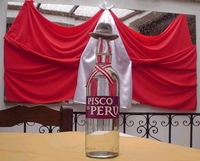 know is that Pisco’s roots can be traced back to 16th century Colonial rule, when the Spanish invaders brought grapes to South America. After Spain’s King Phillip II banned the production of wine in the colonies, the locals began distilling the grapes to make a sort of brandy. know is that Pisco’s roots can be traced back to 16th century Colonial rule, when the Spanish invaders brought grapes to South America. After Spain’s King Phillip II banned the production of wine in the colonies, the locals began distilling the grapes to make a sort of brandy.
By the 17th century this brandy had become a local favorite, and was particularly popular with the sailors who transported products between the old and new worlds. These mariners are usually credited with naming the drink after the Peruvian port from which it may have been first exported. Pisco remained a favorite drink of sailors crisscrossing the ocean until its popularity was surpassed by rum, which was both smoother and less expensive.
A variety of different grapes can be used in the production of Pisco, many of them aromatic varieties from the Muscat family. Like any brandy-type liquor, Pisco may or may not be aged in oak barrels. Like all brandies, Pisco varies in quality, ranging from bland and sweet to a potion admired for its complex aromas and flavors.
Pisco had a surprising life in19th century California, where it was a favorite drink in Gold Rush country. The poet Rudyard Kipling so loved Pisco that he wrote an ode in which he described it as “compounded of the shavings of cherubs’ wings,” and compared it to “the glory of a tropical dawn, the red clouds of sunset, and the fragments of lost epics by dead masters.” (Do you think these flashy poetics may have been the result of too much Pisco?)
A cocktail called Pisco Punch was created in the 19th century at the Bank Exchange, a trendy turn-of-the-century bar in San Francisco. The Punch was wildly popular until Prohibition closed the Bank Exchange down permanently. But now Pisco is back. As a relative newcomer on 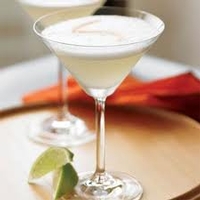 the hip cocktail scene in the US, Pisco’s popularity is growing fast (according to the Comision Nacional del Pisco of Peru, exports of Peruvian Pisco to the US rose an astounding 81% last year). the hip cocktail scene in the US, Pisco’s popularity is growing fast (according to the Comision Nacional del Pisco of Peru, exports of Peruvian Pisco to the US rose an astounding 81% last year).
Pisco Sour, the descendent of San Francisco’s Pisco Punch, is undoubtedly the most popular cocktail in Chile and Peru. I’ve had many Chilean Pisco Sours over the years, a few of them cloyingly sweet, but the well made ones are both exhilarating and refreshing. Among my favorite versions of the beverage is the exceptional Pisco Sour served at the lovely La Mar restaurant in Santiago (and at the La Mar satellites in Lima, San Francisco, and soon Manhattan).
La Mar Pisco Sour:
3 ounces Pisco
1ounce lemon juisce
1 ounce simple syrup
1 ounce egg white
Shake over ice, strain and top with angostura bitters. Cherubs’ wings optional.
Posted by Marguerite Thomas at 10:55 AM
|
|
June 11, 2011
I've been inspired by the Elyse Luray book, "Great Wines Under $20," which is available for $9.77 in paperback from Amazon. But first let me explain that "great" in this context often means very good for the money.
.jpg) That was the theme of many judges at the recent Critics Challenge International Wine Competition in San Diego. There was no shortage of fabulous but expensive wine. Just look at the Wine of the Year, the G.H. Mumm Brut Rose Champagne, and the Best of Show red wine, the 2007 Cakebread Merlot from the Napa Valley. One is $70 retail, while the other is $51. That was the theme of many judges at the recent Critics Challenge International Wine Competition in San Diego. There was no shortage of fabulous but expensive wine. Just look at the Wine of the Year, the G.H. Mumm Brut Rose Champagne, and the Best of Show red wine, the 2007 Cakebread Merlot from the Napa Valley. One is $70 retail, while the other is $51.
But a wine didn't have to be expensive to impress the critics. On the contrary, there were a bevy of gold and platinum medal-winners that carried a modest price tag. Luray's book has inspired me to sift through the results and make note of the best of these inexpensive gems.
I have culled out only the wines with which I am familiar or have tasted over the Critics Challenge weekend. These are my favorites, in alphabetical order, and all won a gold medal unless otherwise noted. A complete list of winners can be found at www.CriticsChallenge.com.
Banfi 2007 Chianti Classico Riserva DOCG, Tuscany, Italy ($18) — Banfi is best known for its Castello Banfi Brunello di Montalcino, with a much heftier price tag. The wines from the Chianti Classico district are both affordable and superb. The Riserva (platinum) is smooth and supple, with excellent structure and a lingering finish that invites another sip. And at $13, the non-reserve Chianti Classico won a silver medal.
Boro Hills 2010 Sauvignon Blanc, Marlborough, New Zealand ($10) — Not sure how they pull this off at this price, but Boro Hills Sauvignon delivers the pungent aromas associated with New Zealand Sauvignon Blanc as well as sweet notes of gooseberry, tangerine and lime.
.jpg) Campo Viejo 2007 Rioja Crianza DDOC, Spain ($10) — This is a delicious entry level red from one of the world's greatest wine regions; a place where prices haven't quite caught up to quality. If value and budget are huge considerations, Spain offers both along with outstanding quality. Campo Viejo 2007 Rioja Crianza DDOC, Spain ($10) — This is a delicious entry level red from one of the world's greatest wine regions; a place where prices haven't quite caught up to quality. If value and budget are huge considerations, Spain offers both along with outstanding quality.
Casillero del Diablo 2009 Carmenere Reserva, Rapel Valley, Chile ($12) — You do know the 'C' in Chile stands for cheap. Cheap from Chile doesn't equate to dull or boring. This Carmenere (a forgotten Bordeaux grape variety until revived in Chile) is extremely satisfying.
Erath Winery 2009 Pinot Noir, Oregon ($19) — Shocking, I know. And you thought you had to spend $30 or more to get one of those earthy, spicy Oregon Pinots. Erath is the real deal and the price is not a mirage.
Feudi di San Gregorio 2008 Aglianico 'Rubrato,' Irpinia IGT, Italy ($16) — This is one of my favorites reds from the competition, at any price. It is structured and earthy, with lovely dark-fruit aromas and spice accents. Aglianico is one of Italy's greatest red wines, but it's not widely known or understood here in the U.S.
Gonzalez Byass Oloroso Dulce 'Solera 1847,' Jerez DDO, Spain ($19.99) — This is amazing wine for the price. If you have a sweet tooth following dinner, or simply want something special to serve with savory cheeses, this beautiful Sherry won't break the bank.
.jpg) Hahn 2009 Merlot, Central Coast ($12) — This is one of the better value wineries in California, and the secret is their exceptional vineyard sources throughout Monterey and San Luis Obispo counties. The Merlot has guts, or it wouldn't have been a contender for Best of Show red wine. The price is simply ridiculous for a wine that yummy. Also, it won gold with a delicious Monterey County Pinot Gris at the same low price. Hahn 2009 Merlot, Central Coast ($12) — This is one of the better value wineries in California, and the secret is their exceptional vineyard sources throughout Monterey and San Luis Obispo counties. The Merlot has guts, or it wouldn't have been a contender for Best of Show red wine. The price is simply ridiculous for a wine that yummy. Also, it won gold with a delicious Monterey County Pinot Gris at the same low price.
Handley Cellars 2009 Pinot Gris, Anderson Valley ($18) — One of the best white wines of the weekend and a legitimate contender for Best of Show white wine. Of course, all of the Handler wines are stellar, so the only surprise here is the modest price.
Henry Estate Winery 2008 Pinot Noir, Oregon ($18) — This is another outstanding Oregon Pinot at a great price. Henry is consistently underrated. I have no idea why, because the wines are always top-notch.
Jacob's Creek 2010 Dry Riesling, Barossa Valley, Australia ($14) — Also G 2007 Shiraz Reserve, Barossa ($14) — Yes, many of the world's best dry Rieslings are made in Australia, and Jacob's Creek is one of them.
Kenwood 2010 Sauvignon Blanc, Sonoma County ($10) — I've been buying this wine as a summer house wine for years and can't help but note its remarkable consistency. It always exhibits aromas of fresh grapefruit and dried herbs, with a crisp acidity.
Lockwood 2008 Merlot Estate, Monterey ($15) — This winery owns one of the largest vineyards in southern Monterey County. The price reflects the economy of scale, not poor quality.
Maschio Brut Prosecco, Treviso DOC, Italy ($13) — I have two bottles of this in the fridge, even as I type. I served it at the Critics Challenge judges' reception. I think it's the perfect quaffing bubbly for summer. You get the idea.
Navarro Vineyards 2009 Pinot Noir, Mendocino ($19) — Consider that Navarro is among the most committed wineries in California. That commitment is to high quality wine from Anderson Valley and Mendocino County fruit. Mission accomplished, and, no, the price is not a typo!
.jpg) Nobilo 2010 Sauvignon Blanc 'Regional Collection,' Marlborough, New Zealand ($14) — One of the top Sauvignon producers in New Zealand, Nobilo spares nothing in its quest for quality, and that extends even to its least expensive wines, the "Regional Collection." One of my go-to Kiwi Sauvignons when I see it on a wine list. Nobilo 2010 Sauvignon Blanc 'Regional Collection,' Marlborough, New Zealand ($14) — One of the top Sauvignon producers in New Zealand, Nobilo spares nothing in its quest for quality, and that extends even to its least expensive wines, the "Regional Collection." One of my go-to Kiwi Sauvignons when I see it on a wine list.
Robert Oatley 2010 Rose of Sangiovese, Mudgee, Australia ($15) — It was the slam-dunk winner in the rose category, and it's been a winner in every wine competition that it has entered. It will be a winner at your backyard barbecue, too. It has lovely balance, low alcohol, pretty fruit and a friendly price. More rose like this, please!
Tangent 2009 Albarino, Paragon Vineyard, Edna Valley ($17) — If you love Albarino, which I do, this is just about the finest domestic Albarino out there. It can stand head-to-head with Albarino from Spain's Rias Baixas district and hold its own. It's beautifully structured and delicious.
Tapena 2009 Tempranillo, Tierra de Castilla, Spain ($10) — I've recommended this wine many times before and nothing has changed. It exhibits lovely red and black fruit character, with good richness and freshness. The tannins are supple and sweet, making it easy to drink and almost way too perfect for summer picnics and al fresco dining.
Villa San-Juliette 2009 Sauvignon Blanc, Paso Robles ($15) -- This wine won a platinum and compete in the vote for Best of Show white wine. Easy to see why. It shows lovely aromas of stone fruit and citrus, with fresh acidity and a clean, crisp finish.
Zonte's Footstep 2010 Verdehlo 'Sea Mist,' Langhorne Creek, Australia ($14) — This crisp, mineral-driven white from southeastern Australia was one of the finest whites I tasted at Critics Challenge, regardless of price.
Posted by Robert Whitley at 7:37 AM
|
|
June 9, 2011
I don’t know your father, but being one myself, I can say with strong assurance that he does not want the things that you are most likely to buy for him.
Not being a moron, he is perfectly capable of buying a polo shirt for himself, and he doesn’t want a tie any more than your mother wants a vacuum cleaner. What he actually wants is something that is directly pleasurable, and that he wouldn’t have thought to get himself.
In brief, Daddy wants Port, though he probably doesn’t know that yet.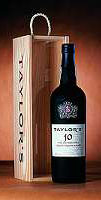 He may remain in the dark because he shares the common misconception that Port is a winter drink, but that makes Father’s Day the perfect time to enlighten him. He may remain in the dark because he shares the common misconception that Port is a winter drink, but that makes Father’s Day the perfect time to enlighten him.
It may make some sense to reserve vintage Port for fall, winter or spring--but no more than it makes sense to reserve Riesling for summer. In any case, we can sidestep that entire issue because vintage Port is hardly the only sort of Port, and vintage Port isn’t the best gift anyway. That title clearly belongs to aged Tawny Port, and the plain fact of the matter is that aged Tawny Port is fantastic all year ‘round.
Including in summer. I’ve been to Oporto and the Douro Valley several times, but one of the most memorable visits was in September of 2003, a famously hot year. For an entire week, I was served aged Tawny Port. Chilled.
It was absolutely delicious, and though I assumed that the chilling was 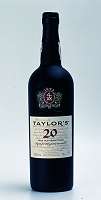 a temporary reaction to climatic conditions, I was wrong. Those who actually make the stuff routinely serve it chilled, and for multiple reasons. Cooler temperatures tamp down Port’s rather heady alcohol. Chilling brings up Port’s acidity, and allowing aged Tawny Port to warm slowly as it comes up to room temperature makes an already phenomenally complex wine even more complex, as the nuances that come to the fore are changed with each sniff and sip. a temporary reaction to climatic conditions, I was wrong. Those who actually make the stuff routinely serve it chilled, and for multiple reasons. Cooler temperatures tamp down Port’s rather heady alcohol. Chilling brings up Port’s acidity, and allowing aged Tawny Port to warm slowly as it comes up to room temperature makes an already phenomenally complex wine even more complex, as the nuances that come to the fore are changed with each sniff and sip.
There are other reasons why aged Tawny Port is a perfect gift, not least among them being that your father can enjoy his bottle over the course of an entire month if he wishes to replace the stopper and keep his present in the refrigerator. It won’t be quite as fresh and complex at the end of that month, but it will be pretty close to what it was on Dad’s Day, whereas almost any other wine would long since have cracked up.
Another advantage is that you’ve got four spending options at your disposal, since you can purchase aged Tawnies at 10, 20, 30 or 40 years of ageing.
All of the brands that are sold in export markets are good, and most are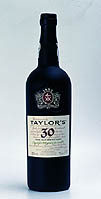 very good, but this year I want to recommend the wines of my favorite house from that torrid summer of 2003: Taylor Fladgate. very good, but this year I want to recommend the wines of my favorite house from that torrid summer of 2003: Taylor Fladgate.
Taylor’s vintage Ports are the highest rated (and most expensive) in many declared years, which is a fact that shouldn’t be allowed to eclipse the excellence of the house’s aged Tawnies. The 10 Year Old bottling is very good, and approachably priced at $35. Like all aged Tawnies, it is terrific after a meal with many desserts, including chocolate ones which are very unkind to other dessert wines.
The step to the Taylor Fladgate 20 Year Old is a big step up, in my view. Although I adore the 30 and 40 Year Old bottlings, you should know that many experts regard these as special-occasion luxuries while thinking of 20 Year Old as the prime example of the whole category. I tend to agree with this view, though that leaves open the question of just how special an occasion you regard Father’s Day as being. Perhaps price will decide that issue for you, and the 20 Year Old from Taylor sells for about $55. It is an amazing wine, and though it is only second in a four-fold hierarchy, it is twice as complex as the 10 Year Old bottling. I adore this wine every time that I taste it, and think it the best buy in the entire line.
Still, if you really want to buy something extraordinary for your father,  the 30 and 40 Year Old Tawnies from Taylor are the way to go. Suggested retail prices for these are $120 and $200. These numbers may seem shocking, but they aren’t when one considers the inventory costs involved in wines like these, not to mention the loss of 3% of the wine each year due to evaporation, which is a massive loss when compounded over 30 or 40 years. These two wines are almost impossibly complex, showing all sorts of nuances suggesting spicy, nutty, leathery, floral, and dried fruit notes that are so intricate with such interesting interplay that true wine lovers can be rendered speechless. the 30 and 40 Year Old Tawnies from Taylor are the way to go. Suggested retail prices for these are $120 and $200. These numbers may seem shocking, but they aren’t when one considers the inventory costs involved in wines like these, not to mention the loss of 3% of the wine each year due to evaporation, which is a massive loss when compounded over 30 or 40 years. These two wines are almost impossibly complex, showing all sorts of nuances suggesting spicy, nutty, leathery, floral, and dried fruit notes that are so intricate with such interesting interplay that true wine lovers can be rendered speechless.
Speechlessness may or may not be an advantage, depending on your particular father. What I can say for sure is that--regardless of how well you get along with your dad--you’ll be getting along with him a lot better after he receives his bottle of aged Tawny.
Posted by Michael Franz at 11:08 AM
|
|
June 7, 2011
Fifty years ago, although wine certainly was being made elsewhere, fine wine--that is, wine valued for more than just calories or escape--was almost exclusively produced in select places in Europe, primarily in France. Then came what many commentators have dubbed “the wine revolution.” In less than two generations’ time, everything changed.
First, in the 1970s and 1980s, Australia and California burst onto the scene. The former made the biggest impact with exports, the latter in  the American market. Both, however, introduced a fruit-forward, varietally-focused style that in short measure became emulated the world over. the American market. Both, however, introduced a fruit-forward, varietally-focused style that in short measure became emulated the world over.
In the 1990s, it was Chile’s and New Zealand’s turn. Then in the 2000’s, Argentina and South Africa took the stage. Meanwhile, other parts of the United States began to challenge California’s dominance, just as other European countries were challenging France’s. While the challenge sometimes took the form of imitation, consumers ended up being flattered more than anyone else. A wave of exciting wines, some made in a similar style but others more individualistic, flooded store shelves and restaurant lists, giving wine lovers ever more delectable choices.
So what’s next? As in so many areas of contemporary life, the pace of change has been dizzying. While it may slow down, it may also continue or even accelerate. So where are new fine wines apt to come from a generation from now?
While it’s always dangerous to try to predict the future, a few things do seem fairly clear. One is that few non-European countries not already part of the wine revolution have much of a wine culture. Thus if new parts of sub-Saharan Africa, Asia, or South America are to embrace the grape, attitudes about why wine matters will have to change there. That’s precisely what happened in New Zealand twenty years ago, so it could happen in, say, Brazil or Zimbabwe, but it does remain a proverbial tall order.
There’s a lot of talk these days about China, and to a lesser extent India, becoming significant wine-producing countries. It’s worth remembering, though, that both have massive domestic markets that likely will drink up anything and everything made there. If either country ever produces its own version of Château Lafite, odds seem good that you would have to go there to taste it.
The only places in the world not now fully part of the wine revolution that do have histories of serious wine production are Eastern Europe, North Africa, and the Near East. My guess, and it’s only a guess, is that they’ll come next.
Wine already is a regular part of life from Hungary south into the Balkans and east into Ukraine. Though some exceptions exist, most of the wine exported today from countries like Bulgaria, Moldova, and Romania is of fairly ordinary quality. The ongoing global economic crisis hasn’t helped matters improve, but I suspect we’ll see real changes there in the years to come. There already are some very classy wines coming our way from Croatia, Hungary, and Slovenia. Look for more.
For both political and ideological reasons, it’s difficult to be as sanguine about North Africa and the Near East, where in many places all alcohol remains contraband. Yet some of the world’s oldest wine cultures came in Egypt, Iran, Turkey, and the Transcaucasian countries of Armenia, Azerbaijan, and Georgia. And sixty years ago, Algeria was one of leading wine exporters in the world. Who knows what will happen sixty, thirty, or even ten years from now? Cultural conditions will have to change, but then no other parts of the world seem to be changing faster these days.
To echo an old cliché, the only thing we can be sure of is that things will in fact change. And with wine, if the recent past can serve as prelude, that change should be full of delicious promise, especially in places that few consumers now know much about....
Posted by Paul Lukacs at 9:01 AM
|
|
June 5, 2011
The venue is Austin, Texas, the event is the annual conference of the International Association of Culinary Professionals (IACP), the time is last weekend. Since I am woefully undereducated about bitters, I thought a workshop entitled “It’s Better to be Bitter: The Hows and Whys of Bitters” would fun to attend. But the foremost bitter truth about bitters this morning is this: My plane was delayed, so I’ve arrived at the workshop an hour late.
As I slide into my seat in the crowded conference room my enthusiasm definitely wanes. Lined up in front of me are six shot glasses filled with various bitters. They’re certainly colorful, but I’m not sure what I’m supposed to do with this assortment of liquids. The only ones I’ve heard of are Angostura and Pechaud (this one is neon red, like Campari). My fellow bitters participants are merrily mixing together various combinations of these potions with Ginger Ale or club soda, or layering them in various combinations, but since I’ve missed the explanatory part of the session I have no idea what the goal of this exercise is. My spirits lift when we’re each given a glass filled to the brim with rye whiskey, Noilly Prat red vermouth, St. Germain and a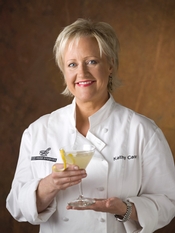 dash of bitters. These bitters were made by Kathy Casey, a Seattle based cocktail and beverage program consultant who is leading the workshop. She point out that the charm of this particular Manhattan is the St. Germain. “The elderberry in St. Germain softens the entire effect,” she explains. I take a couple of sips. Did that pleasurable purring sound come from me? Note to self: Buy a bottle of St. Germain. dash of bitters. These bitters were made by Kathy Casey, a Seattle based cocktail and beverage program consultant who is leading the workshop. She point out that the charm of this particular Manhattan is the St. Germain. “The elderberry in St. Germain softens the entire effect,” she explains. I take a couple of sips. Did that pleasurable purring sound come from me? Note to self: Buy a bottle of St. Germain.
I start to take notes from the Power Point visuals on how to make bitters at home: Start with a base of high alcohol, either neutral (vodka, for example), or one that will add its own flavor (rum is typical). Put in some aromatics such as spices, coffee, tea, and/or herbs. Add the bittering agent, typically gentian, cinchona, angelica root, burnt sugar, and/or citrus peels. At this point I am briefly distracted by the deliciousness of my Manhattan, which is how I happen to forget to copy down the part about filtering your bitters. I’m sure that Kathy says something to the effect that using a coffee filter makes it a very long procedure. I’ll have to double check about this on her website.
Someone in the audience asks if cocktails are good with food. “Cocktails are totally being paired with food these days,” Kathy responds enthusiastically. “I’m especially happy about this because bringing the kitchen into the bar has always been my goal.” I find myself lost in thought about all the foods that might go with Manhattans, but I’m brought back to the present when I realize Kathy is discussing another current trend: Barrel aged bitters. “In fact, it isn’t just bitters that are being aged. Aging entire cocktails in oak is a major trend today,” she assures us, citing as an example of this her recent experience with a Negroni (gin, sweet vermouth and Campari) that had been aged three months in an oak barrel. “It was fantastic!” Personally, I’m glad the Manhattan I’ve been savoring hasn’t been barrel aged--it’s fantastic just the way it is.
One important thing I learn this morning is the difference between shaking and stirring a cocktail. “A cocktail that’s all spirits is usually stirred,” Kathy tells us. “A cocktail with juice or other ingredients like that is supposed to be shaken. Shaking aerates the drink and makes it opaque.” Then she adds: “But I never follow the rules. I like my martinis shaken.”
Noting my empty glass, the woman sitting on my right offers me what’s 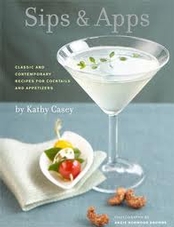 left of her Manhattan. I glance at my watch: eleven-thirty in the morning. Maybe not. Instead, I resolve to buy a copy of Kathy Casey’s book “Sips and Apps: Creative Cocktails, Inspired Classics and Timeless Appetizers” (Chronicle Books). The Manhattan recipe is in it, and I could also learn how to make my own Green Eye Daiquiri, an “inspired classic” that calls for fresh thyme, rum, Chartreuse, fresh lime juice and sugar. Or I could whip together some Riesling and Midori Melon Liqueur and garnish it with lime slices and watermelon to create my own Summer Melon Sangria, perfect for a party. But the “Sips and Apps” cocktail that most intrigues me is the Red Square Martini, which calls for vodka, dry vermouth, and a thinly sliced beet (it turns the drink red). Garnished with lemon rind, a tiny slice of smoked salmon, and a sprig of fresh dill, this might be almost as good as a Manhattan. left of her Manhattan. I glance at my watch: eleven-thirty in the morning. Maybe not. Instead, I resolve to buy a copy of Kathy Casey’s book “Sips and Apps: Creative Cocktails, Inspired Classics and Timeless Appetizers” (Chronicle Books). The Manhattan recipe is in it, and I could also learn how to make my own Green Eye Daiquiri, an “inspired classic” that calls for fresh thyme, rum, Chartreuse, fresh lime juice and sugar. Or I could whip together some Riesling and Midori Melon Liqueur and garnish it with lime slices and watermelon to create my own Summer Melon Sangria, perfect for a party. But the “Sips and Apps” cocktail that most intrigues me is the Red Square Martini, which calls for vodka, dry vermouth, and a thinly sliced beet (it turns the drink red). Garnished with lemon rind, a tiny slice of smoked salmon, and a sprig of fresh dill, this might be almost as good as a Manhattan.
Posted by Marguerite Thomas at 12:22 PM
|
|
June 3, 2011
.jpg) Foreign wineries entering U.S. competitions, especially those based in California, generally do so at their own peril. The home-field advantage for domestic wines is "palatable," considering the local wines are the most familiar and thus the most comfortable to evaluate for your garden-variety wine judge, who in most cases works in some capacity in the wine industry. Foreign wineries entering U.S. competitions, especially those based in California, generally do so at their own peril. The home-field advantage for domestic wines is "palatable," considering the local wines are the most familiar and thus the most comfortable to evaluate for your garden-variety wine judge, who in most cases works in some capacity in the wine industry.
Not so at the Critics Challenge International Wine Competition, staged annually in San Diego, Calif., for the past eight years. Foreign entries ruled, at least in the championship round, at the 2011 Critics Challenge over Memorial Day weekend.
The G.H. Mumm Brut Rose Champagne ($70) was voted Wine of the Year and Best of Show sparkling wine by a wide margin among the 15 internationally known wine journalists/critics who spent two days tasting and rating nearly 1,400 entries from 16 nations.
The Wine of the Year vote came after the competition had been narrowed to five Best of Show wines: Hagafen 2010 White Riesling, Devoto Vineyards, Lake County ($18, best white); Cakebread Cellars 2007 Merlot, Napa Valley ($54, best red); Robert Oatley 2010 Rose of Sangiovese, Mudgee, Australia ($15, best rose); Inniskillin 2007 Vidal Ice Wine VQA, Niagara Peninsula, Canada ($60, best dessert wine); and the Champagne Mumm Brut Rose as best sparkling.
Mumm claimed nine votes from the 15 judges. The Hagafen Riesling was runner-up with four votes. The triumph by Mumm marked the third time in eight years that a Champagne house had taken the top prize at Critics Challenge. The Critics Challenge is unique among wine competitions in that all of the judges are noted wine journalists with multiple book, magazine and newspaper columns on the resume.
Champagne Mumm also received the Director's Award as Winery of the Year for its stellar performance, which included gold awards for the other two G.H. Mumm wines entered — Mumm de Cramant Grand Cru ($75) and Mumm Cordon Rouge Brut ($35).
.jpg) In addition to the major prizes, 681 awards were given to wines of merit — nearly half of the 1,380 wines entered. Critics Challenge recognizes exceptional wines with silver and gold awards, with a handful attaining platinum status by advancing to the championship rounds, where Best of Show and Wine of the Year are determined. In addition to the major prizes, 681 awards were given to wines of merit — nearly half of the 1,380 wines entered. Critics Challenge recognizes exceptional wines with silver and gold awards, with a handful attaining platinum status by advancing to the championship rounds, where Best of Show and Wine of the Year are determined.
All of the winners have been posted on the Critics Challenge results page, and I have taken note of several of the most impressive performances. To wit:
Bracey Vineyards, a little-known boutique brand produced at a custom-crush facility in Northern California, entered six wines and medaled with five, including platinum awards for its 2007 Cabernet Sauvignon, Howell Mountain ($70) and 2006 Cabernet Sauvignon "TKL", Oakville ($75).
Cakebread Cellars, a Napa Valley mainstay, entered but two wines and placed both in the championship round. Besides the Best of Show red wine, the 2007 Merlot, Cakebread earned platinum with its 2008 Cabernet Sauvignon, Napa Valley ($61).
Cameron Hughes, a San Francisco-based negociant, picked up a stunning total of 14 awards, including four golds. Cameron Hughes purchases odd lots of finished wine from super-premium wineries and bottles them under his own name at a fraction of the price the wines would sell for at the source. For example, one of his gold winners is a 2008 Meritage, Napa Valley that retails for $13. The price range on his 14 award-winners was a low of $10 and a high of $22.
.jpg) Frogtown Cellars, the Lumpkin County, Ga., winery that was the subject of a recent Wine Talk column, took four awards — all gold. Frogtown scored with its cabernet franc, cabernet sauvignon, merlot and tannat. Frogtown Cellars, the Lumpkin County, Ga., winery that was the subject of a recent Wine Talk column, took four awards — all gold. Frogtown scored with its cabernet franc, cabernet sauvignon, merlot and tannat.
Frank Family Vineyards of the Napa Valley continued its strong performance in wine competitions this year with gold awards for the only two wines it entered — the 2009 Pinot Noir, Carneros ($35) and 2009 Chardonnay, Carneros ($32.50).
Gloria Ferrer, the Carneros winery that specializes in sparkling wine, gathered nine medals, but its two platinums were both for pinot noir — the 2007 Estate Pinot Noir ($22) and the 2006 Rust Rock Terrace Vineyard ($40). Another pinot and three of its sparkling wines earned gold.
.jpg) Gnarly Head scored big for the value wines, winning a platinum with its 2010 California Chardonnay ($10.99) and gold for its 2009 Lodi Zinfandel ($10.99). Gnarly Head scored big for the value wines, winning a platinum with its 2010 California Chardonnay ($10.99) and gold for its 2009 Lodi Zinfandel ($10.99).
Jacobs Creek, another value wine from Australia's Barossa Valley, won nine awards, including one platinum and three golds, with no wine costing more than $13.99. The platinum winner was the 2010 Dry Riesling, Barossa ($13.99).
John Duval, the man and the winery, entered three wines from Barossa and took one platinum and two golds. Duvall, the man, was the longtime winemaker for Penfolds Grange, Australia's most important wine. Duvall, the wine, is not cheap. Its platinum-winning shiraz, the 2006 Eligo, retails for a cool $100.
Jordan Vineyard & Winery, long a star in California's Alexander Valley, entered but two wines — its 2007 Cabernet Sauvignon, Alexander Valley ($52) and its 2009 Chardonnay, Russian River Valley ($29) — and took a gold award with each.
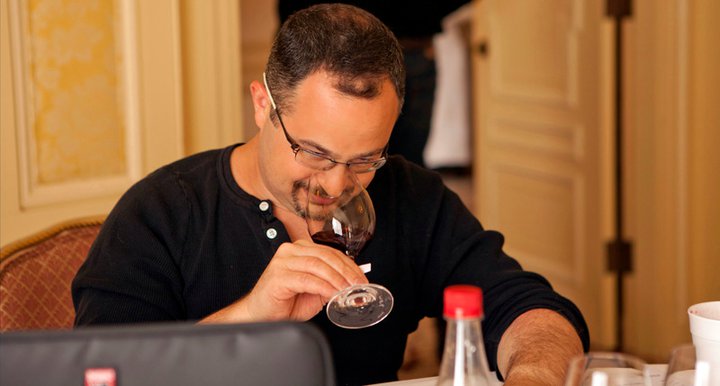 Kilikanoon is a rocking winery in Australia's Clare Valley, and it was on its game in the 2011 Critics Challenge, winning nine awards, including two platinums — 2007 Cabernet Sauvignon, Block's Road ($30) and 2010 Riesling, Mort's Block, Watervale ($20) — and four golds. Kilikanoon is a rocking winery in Australia's Clare Valley, and it was on its game in the 2011 Critics Challenge, winning nine awards, including two platinums — 2007 Cabernet Sauvignon, Block's Road ($30) and 2010 Riesling, Mort's Block, Watervale ($20) — and four golds.
Lafond Winery of Santa Barbara had two pinots in the championship round, including the Best of Class Pinot Noir, the 2006 Pinot Noir, Lafond Estate Vineyard ($48). Its other platinum pinot was the 2009 SRH ($27). Lafond also won a gold award with its 2007 Chardonnay, Sanford & Benedict Vineyard, Sta. Rita Hills ($38).
V. Sattui, perhaps the Napa Valley's most award-winning winery, took the prize for most medals at the 2011 Critics Challenge with 15. Seven of those were gold, but for the first time in recent memory V. Sattui failed to place a wine in the championship/platinum round of Critics Challenge, where it has been Winery of the Year twice. Despite the fact the ground didn't move, that counts as an earthquake at the Critics Challenge.
Posted by Robert Whitley at 11:01 AM
|
|
June 1, 2011
When was the last time that the word “refreshing” came to mind when drinking a glass of California white wine? In my case at least, it’s been quite a while. “Rich,” yes. “Lush,” certainly. But refreshing? All too rarely.
I thought of this when reading Eric Asimov’s column in last Wednesday’s New York Times. He was addressing southern Italian whites, and he began by declaring that their radically improved quality constitutes “one of the more dramatic examples of how the world of wine has changed in the last twenty-five years.” Why, I started to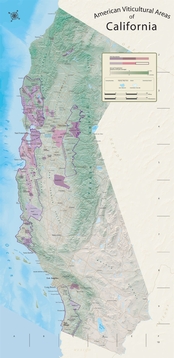 wonder, hasn’t California been part of that change? wonder, hasn’t California been part of that change?
Other places certainly have been. Vibrant, refreshing whites are coming today from places no one ever before imagined could produce such wines. Southern Italy is a great example, but so too are Sicily and Sardinia, as well as Rueda in Spain, parts of the Languedoc in France, both the mainland and the islands in Greece, Salta in Argentina, the Western Cape in South Africa, and many more.
The terroirs in these regions are very different, but all are demonstrating the capacity to grow grapes that can yield dynamic and refreshing white wines. Acids are kept high; oak plays little or no role; and the wines taste delicious. Whether made with widely recognized grape varieties such as Sauvignon Blanc, or with more obscure because usually local ones like Fiano di Avelino or Verdejo, these wines share a stylistic profile that makes them ideal for warm weather drinking.
Though exceptions certainly exist, California by and large is not producing wines in this style. Perhaps it’s the climate? After all, conventional wisdom long has had it that most prime grape growing regions in the Golden State are too warm for high acid, light-bodied, refreshing wines. Yet the emergence of all these new wines from elsewhere challenges that line of thought. After all, southern Italy, like central Spain and Mediterranean France, can be swelteringly hot in the 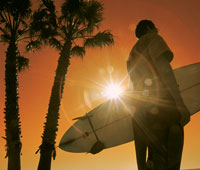 summer. Moreover, California used to produce wines in this style. (Anyone remember old-fashioned, generic “chablis?” It wasn’t complex or sophisticated, but it did taste crisp.) summer. Moreover, California used to produce wines in this style. (Anyone remember old-fashioned, generic “chablis?” It wasn’t complex or sophisticated, but it did taste crisp.)
More than anything else, modern winemaking technology, particularly ever-improved temperature control equipment, is what has enabled winemakers in other warm locales to fashion such refreshing white wines. California vintners clearly have access to it, so the problem can’t be a lack of either equipment or know-how.
No, it’s evidently a lack of will. With an almost entirely domestic market, California vintners apparently feel little need to diversify stylistically. Particularly over the past twenty-five years, the history of Golden State white wine has involved experimenting with different grape varieties, but by and large aping a style already popularized with Chardonnay. This doesn’t mean always using new oak barrels, or inducing malolactic fermentation, or retaining residual sugar. It does, however, mean, emphasizing fullness and richness at the expense of vivacity and verve.
To my mind, that’s a shame. A generation ago, the state’s vintners played a leading role in the global white wine revolution. Today, I’m sorry to say, they’re lagging behind.
* * *
Agree or disagree? Write to me at plukacs@verizon.net
Posted by Paul Lukacs at 7:10 AM
|
|
 |
|